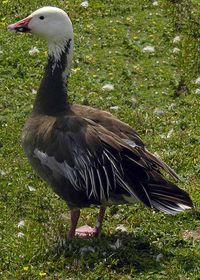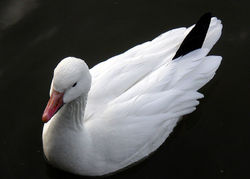Snow Goose
2007 Schools Wikipedia Selection. Related subjects: Birds
| iSnow Goose | ||||||||||||||
|---|---|---|---|---|---|---|---|---|---|---|---|---|---|---|
 |
||||||||||||||
|
|
||||||||||||||
 Least Concern (LC) |
||||||||||||||
| Scientific classification | ||||||||||||||
|
||||||||||||||
|
|
||||||||||||||
| Chen caerulescens (Linnaeus, 1758) |
||||||||||||||
|
|
||||||||||||||
|
||||||||||||||
|
|
||||||||||||||
|
Anser caerulescens |
The Snow Goose (Chen caerulescens) is a North American species of goose. Its name derives from the typically white plumage.
The American Ornithologists' Union places this species and the other two "white" geese in the genus Chen, while some other authorities place it in the more traditional "grey" goose genus Anser.
This goose breeds in northern Canada and the northeastern tip of Siberia, and winters much further south in the continent in the southern USA and beyond. These birds migrate in large flocks, often visiting traditional stopover habitats in spectacular numbers.
The larger of the two subspecies, the Greater Snow Goose (C. c. atlanticus), nests to the north of eastern Canada. The smaller subspecies, the Lesser Snow Goose (C. c. caerulescens), commonly occurs in two plumage variants. White-phase birds are white except for black wing tips, but blue-phase geese have bluish-grey plumage replacing most of the white except on the head, neck and tail tip. White- and blue-phase birds do interbreed and the young may be of either type. Blue-phase birds are rare among the Greater Snow Geese.
This species is a rare vagrant to Europe, but a frequent escape from collections and an occasional feral breeder.
The nest is usually located in a slightly elevated location on the ground, built with plant material and lined with down.
These birds mainly eat plant material found in shallow water or on land. Outside of the nesting season, they usually feed in flocks. In winter, these birds feed on left-over grain in fields.
The population of Greater Snow Geese was in decline at the beginning of the 20th century, but has now recovered to sustainable levels.
Snow Geese in North America have increased to the point where the tundra breeding areas in the Arctic and the saltmarsh wintering grounds are both becoming severely degraded, and this affects other species using the same habitat. Extending hunting of this wary species has made no significant impact on numbers. On the other hand, the Siberian population is declining due to predation by Arctic Foxes and habitat disturbance by reindeer.
Snow Geese are rare visitors to the British Isles, where they are seen regularly among flocks of Barnacle, Brent and Greenland White-fronted geese. There is also a feral population in Scotland.


